In this Issue
- Codling moth: updated dates of first generation spray timings
- Fire blight – post-infection: inspect flower/fruit clusters on apple/pear trees for wilting
- Woolly apple aphid: colonies are just starting to multiply in northern Utah
- Apple powdery mildew: look for infections on new, terminal (shoot ends) foliage
- Brown mite: A cool-season mite that was seen in high numbers in Utah County on apple
- Cherry powdery mildew: new infections are just starting to appear
APPLE, PEAR
Codling Moth
Updated codling moth treatment dates
View a pdf of the spray timing table. Be sure to read the instructions at the top of the page, for how to read the table.
Due to the warmer weather earlier this week, the spray dates have been updated on the table.
Treatment
- See the May 11, 2022 post for spray options for backyard growers (scroll down to Codling Moth heading and see table), and for options on how often to spray.
- Options for commercial growers.
Fire Blight – Post-Infection
Inspect fruit clusters starting 2 weeks after full bloom for infections
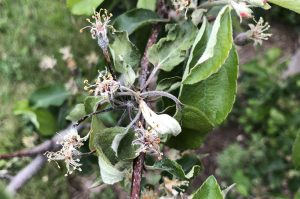
Symptoms of fire blight infections will start to appear 2 to 4 weeks after full bloom. It is important to monitor your apple and pear trees every week. Look for wilted leaves, and fruit clusters that appear shriveled and brown.
Treatment
- Prune out all diseased plant parts as they are found. This will not only prevent the infections from expanding into the tree, but will also reduce the source of bacteria in the area.
- For infections that are caught early, remove twice the length of the visible symptoms.
- For infections that are caught late (that have expanded beyond the fruit cluster), it is important to make the pruning cut 10 to 12 inches beyond the visible symptoms.
- Prune in dry weather only. To be safe, wipe pruners with disinfecting wipes between cuts.
If moisture is predicted after pruning, remove the debris rather than leaving it in the orchard. If conditions are hot and dry, it is OK to leave the debris on the ground and mow it.
Woolly Apple Aphid
Starting to multiply in trees; scout for them now
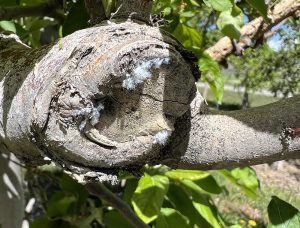
This week, we found small woolly apple aphid colonies in orchards along the Wasatch Front that are just starting to multiply. Woolly apple aphids are first seen where they overwinter in the trees, which is primarily around old pruning cuts. They also overwinter on roots, and some of these stay on roots year-round, while others will migrate up the bark.
Woolly apple aphids are different from typical aphid species in that they feed on twigs, bark and roots, and have a cottony covering on their bodies. We usually do not see these aphids in the trees until mid to late spring.
It is important to scout your own trees to determine when and if a treatment is needed. Start by looking for aphids around the callus wounds of old pruning scars or other wounds, and on root suckers.
Treatment
If woollies are a problem every year, it is best to treat them early. Otherwise, treat them when they increase to the point of covering more about 10% of the tree.
Because of the aphid’s thick, waxy coating, it is important to spray the tree to drip to reach the aphid bodies. Adding oil to the insecticide also helps permeate the coating.
- Backyard growers can use insecticidal soap+1% oil, aimed directly at the colonies, or a stronger product such as Spectracide Triazicide, Bonide Fruit Tree Guard, or GardenTech Sevin, plus 1% oil.
- Options for commercial growers: click here.
Apple Powdery Mildew
Look for white, powdery infections on newest foliage
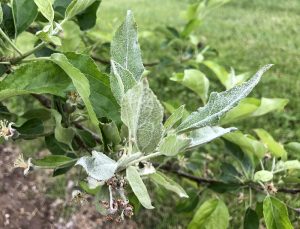
Powdery mildew is visible on apple foliage now. This fungus overwinters on twigs, and as a result, new infections can occur very early in the season. If left untreated, infections can occur all summer long, simply from the humidity within the tree canopy.
If your apples have had powdery mildew in the past, look for infections now. If trees are in bloom, and you find powdery mildew, consider a fungicide application after bloom, with a second application about 5 to 14 days later, depending on the product used (see below).
Cortland, Idared, Gingergold, Braeburn, Gala, and Jonagold are all varieties that are more susceptible.
Treatment
Commercial growers: treatment options are shown by clicking here. For each product, there is a range of days after the treatment name that shows how long the protection interval lasts. Be sure to rotate among fungicide classes.
Residential growers can use:
- Spectracide Immunox or Monterey F-stop: separate applications by at least 14 days and apply as needed
- Sulfur (organic; many brands): apply every 10 days as needed
- Neem oil or 1% horticultural oil (organic; many brands): apply every 3 to 5 days as needed, but not when temperatures will reach 85 F within 4 hours of application
- Potassium bicarbonate (organic; Monterey Bi-Carb, Garden-Ville): apply every 7 days as needed
Brown Mite
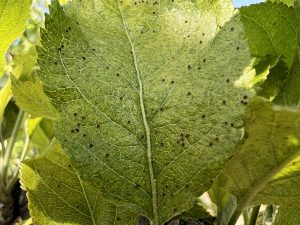
Brown mite (Bryobia rubrioculus) occurs sporadically in Utah orchards, primarily commercial apple orchards. (They have also been found on peach.) They prefer cool, moist spring weather, where they multiply rapidly.
However, unlike spider mites, a low population of brown mites can actually be beneficial in that they serve as a source of food for predatory mites, helping the predatory mite population to increase. Then later in the season, when spider mites become more active in the hot, dry weather, they can be controlled by the predatory mites.
This week, we found low populations of brown mites on apples in Cache County and very high populations in some orchards of Utah County. It seems to occur in orchards under low-spray programs and those using mating disruption.
The brown mite overwinters as an egg that looks similar to the European red mite, and can occur on all fruit tree species. There are several generations per season, but they are most active in spring and fall. Damage is similar to two-spotted spider mites: stippled leaves.
Treatment
- This pest is best managed at the pink stage, but if mites are found now with excessive damage, any miticide or 1% oil will work.
CHERRY
Powdery Mildew on Commercial Tart Cherry
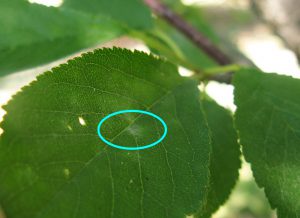
Monitor interior leaves for new infections
We recently found very early powdery mildew infections on tart cherry foliage. These lesions will become more visible in the next week as they enlarge and fill with spores and mycelium. The fungus overwinters as resting spores in fallen leaves, on the orchard floor, or in bark crevices.
Infections on new leaves occurs when spring rains or summer irrigation increase the humidity under the trees, causing the resting spores to release and spread. This pathogen needs 90% humidity and temperatures between 50-78°F for infection to occur.
Leaves, fruit, and fruit pedicels can all become infected. Inspect foliage that occurs near the trunk, and on the lowest, interior twigs (where humidity is highest), for the earliest infections.
Sprays are most effective when applied as soon as the first lesions are spotted, because prevention is the best management option for powdery mildew. Continue sprays at 7 to 14-day intervals until growth hardens off.
Treatment
- Powdery mildew is typically not a problem on backyard cherry trees.
- Commercial tart cherry growers can find options by clicking here.
